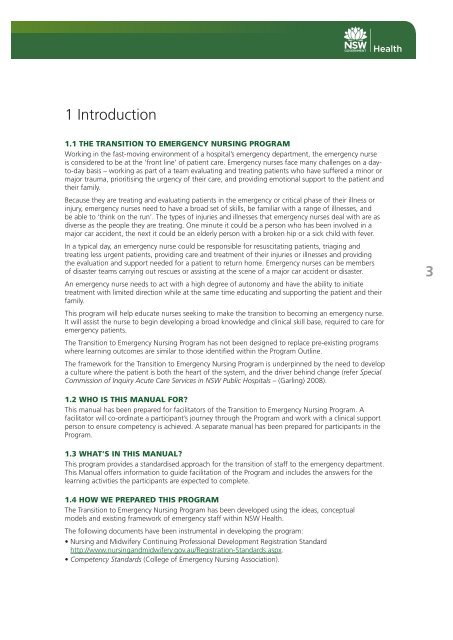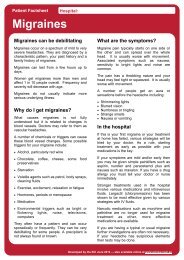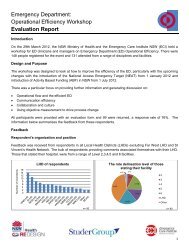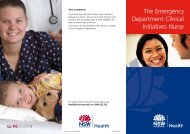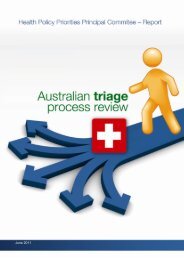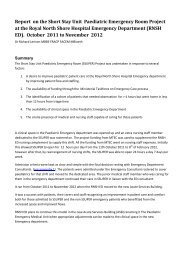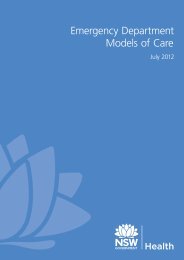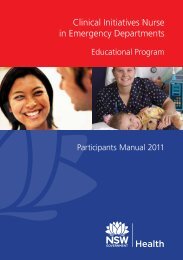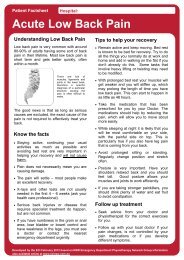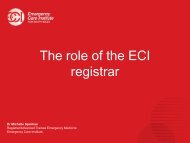Facilitators Manual - Emergency Care Institute
Facilitators Manual - Emergency Care Institute
Facilitators Manual - Emergency Care Institute
Create successful ePaper yourself
Turn your PDF publications into a flip-book with our unique Google optimized e-Paper software.
1 Introduction1.1 The Transition to <strong>Emergency</strong> Nursing ProgramWorking in the fast-moving environment of a hospital’s emergency department, the emergency nurseis considered to be at the ‘front line’ of patient care. <strong>Emergency</strong> nurses face many challenges on a dayto-daybasis – working as part of a team evaluating and treating patients who have suffered a minor ormajor trauma, prioritising the urgency of their care, and providing emotional support to the patient andtheir family.Because they are treating and evaluating patients in the emergency or critical phase of their illness orinjury, emergency nurses need to have a broad set of skills, be familiar with a range of illnesses, andbe able to ‘think on the run’. The types of injuries and illnesses that emergency nurses deal with are asdiverse as the people they are treating. One minute it could be a person who has been involved in amajor car accident, the next it could be an elderly person with a broken hip or a sick child with fever.In a typical day, an emergency nurse could be responsible for resuscitating patients, triaging andtreating less urgent patients, providing care and treatment of their injuries or illnesses and providingthe evaluation and support needed for a patient to return home. <strong>Emergency</strong> nurses can be membersof disaster teams carrying out rescues or assisting at the scene of a major car accident or disaster.An emergency nurse needs to act with a high degree of autonomy and have the ability to initiatetreatment with limited direction while at the same time educating and supporting the patient and theirfamily.3This program will help educate nurses seeking to make the transition to becoming an emergency nurse.It will assist the nurse to begin developing a broad knowledge and clinical skill base, required to care foremergency patients.The Transition to <strong>Emergency</strong> Nursing Program has not been designed to replace pre-existing programswhere learning outcomes are similar to those identified within the Program Outline.The framework for the Transition to <strong>Emergency</strong> Nursing Program is underpinned by the need to developa culture where the patient is both the heart of the system, and the driver behind change (refer SpecialCommission of Inquiry Acute <strong>Care</strong> Services in NSW Public Hospitals – (Garling) 2008).1.2 Who is this manual for?This manual has been prepared for facilitators of the Transition to <strong>Emergency</strong> Nursing Program. Afacilitator will co-ordinate a participant’s journey through the Program and work with a clinical supportperson to ensure competency is achieved. A separate manual has been prepared for participants in theProgram.1.3 What’s in this manual?This program provides a standardised approach for the transition of staff to the emergency department.This <strong>Manual</strong> offers information to guide facilitation of the Program and includes the answers for thelearning activities the participants are expected to complete.1.4 How we prepared this ProgramThe Transition to <strong>Emergency</strong> Nursing Program has been developed using the ideas, conceptualmodels and existing framework of emergency staff within NSW Health.The following documents have been instrumental in developing the program:• Nursing and Midwifery Continuing Professional Development Registration Standardhttp://www.nursingandmidwifery.gov.au/Registration-Standards.aspx.• Competency Standards (College of <strong>Emergency</strong> Nursing Association).


